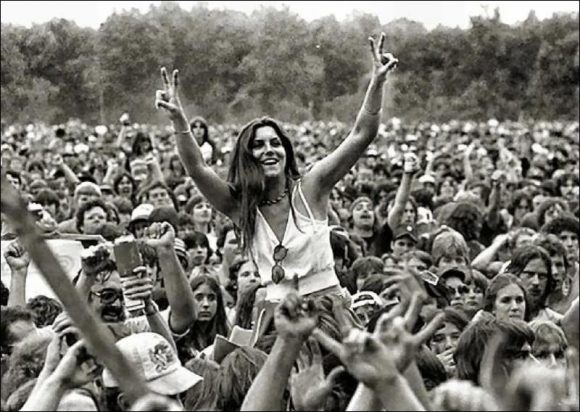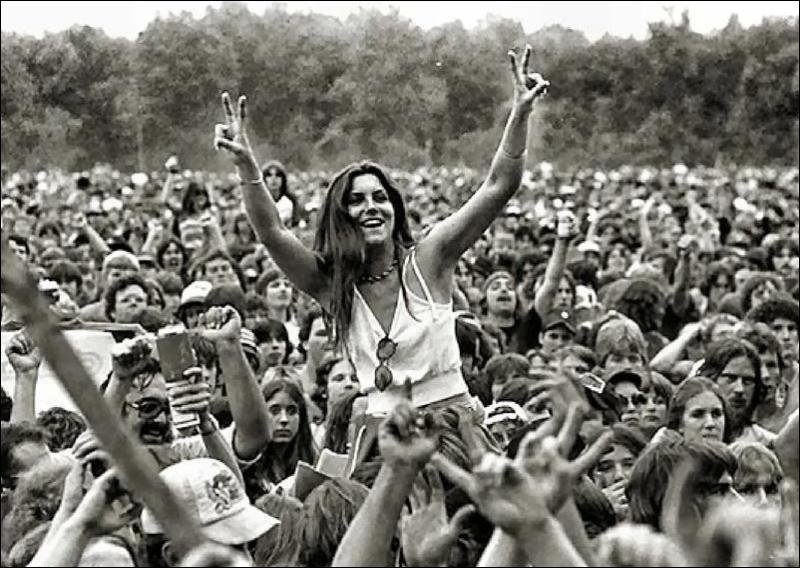If you remember the ’60s, as a popular saying goes, you probably weren’t there. No matter. Madison Avenue is taking you back with a skein of campaigns celebrating sights and sounds of the decade.
The ads are filled with images like Volkswagen buses festooned with groovy graffiti, daisies and other power flowers, peace signs, psychedelic drawings in DayGlo colors and hair, long beautiful hair, shining, gleaming, streaming, flaxen, waxen (to quote a lyric from the era).
Music, too, is being used to invoke the 1960s. Commercials on television, radio and the Internet play tunes like “Daydream” by the Lovin’ Spoonful (1966), “Gimme Some Lovin’ ” by the Spencer Davis Group (1967) and “On the Road Again” by Canned Heat (1968).
The trend may have started in summer 2006 when Ameriprise Financial introduced a campaign with Dennis Hopper, a symbol of the counterculture for his roles in films like “Easy Rider.” It has since expanded to brands like Geico insurance, Lucky jeans, Total cereal and U. S. Trust.
What is most intriguing about the trend is that the ads present many of the contentious aspects of the ’60s the protests, the hippies, the challenge to authority in a positive, even romanticized light.
For instance, a trippy-looking commercial for Total, sold by General Mills, begins, “The ’60s were about change, defying convention,” and ends by proclaiming the cereal as the best breakfast “for mind and body.”
During the ’60s, mass marketers avoided such language, fearful of alienating mainstream consumers. The approach is also a far cry from the demonization of the decade that still pervades political advertising, as evidenced by recent commercials for Senator John McCain that attacked Senator Hillary Rodham Clinton as a product of the ’60s culture.
Content of the video
00:00 Simon and Garfunkel – Sounds of Silence
03:00 The Mamas and Papas – California Dreaming
05:35 Ben E. King – Stand By Me
08:36 Bobby Lewis – Tossin and Turnin
11:04 The Supremes – Baby Love
13:40 Percy Sledge – When a Man Loves a Woman
16:35 The Turtles – Happy Together
19:30 Love is Blue – Music by Paul Mauriat/ Vocal Claudine Longet
22:54 Hey Paula – Paul and Paula
25:13 Mungo Jerry – In the Summertime
28:45 Manfred Mann – Do wah diddy diddy
31:08 The Hollies – Bus Stop
34:01 Petula Clark – Downtown
37:00 The Dave Clark Five – Because
39:20 Peter, Paul, & Mary – Early Morning Rain
42:28 Bobby Vinton – Mr. Lonely
45:10 Elvis Presley – Are You Lonesome Tonight
48:20 The Shirelles – Will You Still Love Me Tomorrow
51:00 Shocking Blue – Venus
54:00 The Archies – Sugar Sugar
56:50 Paul Anka – Put Your Head On My Shoulder (1959 Gotcha! 
59:35 (repeat man!) Mungo Jerry – In the Summertime
01:03:02 Elvis Presley – It’s Now or Never
01:06:25 Frankie Valli and the Four Seasons – Beggin you
01:11:48 The 5th Dimension – Aquarius (Let the Sunshine in)
01:16:35 The Monkees – I’m a Believer
—————————————————————————-
“There are a lot of good things that came out of the ’60s,” said Larry Meli, president and chief operating officer at the AmericanLife TV Network in Washington. “It’s time to point them out.”
AmericanLife TV, which offers reruns of ’60s series like “Lost in Space” and “Mission: Impossible,” is changing its logo to a daisy from a star. The switch is meant to remind baby boomers of the “flower power” slogan as well as a commercial from the 1964 presidential campaign, titled “Daisy,” that portrayed Barry M. Goldwater, who ran against Lyndon B. Johnson, as a warmonger.
“Being more precisely relevant to the audience you’re trying to address is a good thing,” said Ted Ward, vice president for marketing at Geico in Washington, part of Berkshire Hathaway. “There’s a huge opportunity in the baby-boomer group for us to continue to grow our business.”
Geico is running a commercial and a print ad depicting a VW bus decorated with phrases like “right on” and “far out.” The ads are created by the Martin Agency in Richmond, Va., part of the Interpublic Group of Companies.
“Having been from that era, I can relate,” Mr. Ward said, although, he joked, “I never owned that bus.” His Volkswagens of choice, he recalled, were two Beetles and a Karmann Ghia.
U. S. Trust, part of Bank of America, also displays a VW bus in a campaign by another Interpublic agency, Hill, Holliday, Connors, Cosmopulos in Boston. The ads depict a wealthy man today and flash back to show him decades ago, surrounded by friends, inside a bus on a beach.
“The most valuable car in his collection isn’t the Ferrari, the Cobra or the Aston Martin,” a headline declares, “but a 1968 bus.” (Actually, the owner seems to have borrowed parts from models from other years.)
For people in U. S. Trust’s intended audience, “the ’60s “was a formative time in their lives, their wonder years,” said Anne Finucane, chief marketing officer at Bank of America in Boston.
The bus is a symbol “of the values you grew up with, the values that made you successful and the values you want to pass on to your children,” she added.
Indeed, the children of the baby boomers are another reason it is suddenly the time of the season for the ’60s.
“The kids are realizing what that generation was all about and what their fathers and mothers contributed,” said George Lois, who with his son, Luke, is creating a campaign for AmericanLife TV that carries the theme “For baby boomers and their babies.”
The campaign, from an agency in New York aptly named Good Karma Creative, pairs parents and offspring, like the actress Susan Sarandon and her daughter, Eva Amurri; Graydon Carter, the editor of Vanity Fair magazine, and his son, Ash; and the artist James Rosenquist and his daughter, Lily.
Ms. Amurri, for example, praises the way her mother’s generation worked to “change the world” by supporting women’s liberation and opposing the Vietnam War. And Ash Carter describes how his father took part in the movements for racial equality and against the war.
The echo effect from an unpopular conflict that polarized a nation four decades ago has not gone unnoticed.
“I’d like to think that the recent trend of using hippie and flower-power songs and tracks is actually a subliminally subversive tactic,” said Josh Rabinowitz, senior vice president and director for music at the Grey Group in New York, part of the WPP Group, “tapping into a subtle yet palpable collective consumer dissent with the Iraq war.”
For those who may dispute such a political perspective, Mr. Rabinowitz offered another rationale for the music’s comeback: It sounds good.
The songs appeal to a younger demographic as much as they do to boomers, he said, because they are reminiscent of the “indie-inflected” songs heard on TV series like “Grey’s Anatomy” and in films like “Garden State.”
Reactions to the ads are so far predominantly positive, the executives say. “A lot of people are noticing” the Total campaign, said Ann Hayden, worldwide creative director on the General Mills account at Saatchi & Saatchi in New York, part of the Publicis Groupe. “It gives us a starting point for getting people to rethink the brand,” she added.
At Geico, which closely tracks the response to its campaigns, Mr. Ward said the VW bus ads “are working.” For U. S. Trust, Ms. Finucane said, there will be “more ads coming” with a ’60s vibe because “many of our customers identify with it.”
There may also be ads aimed at wealthy investors who fondly recall the ’70s. Asked if they will use symbols of that decade, like spinning disco balls, Ms. Finucane replied, “I hope not.”
Views: 526





